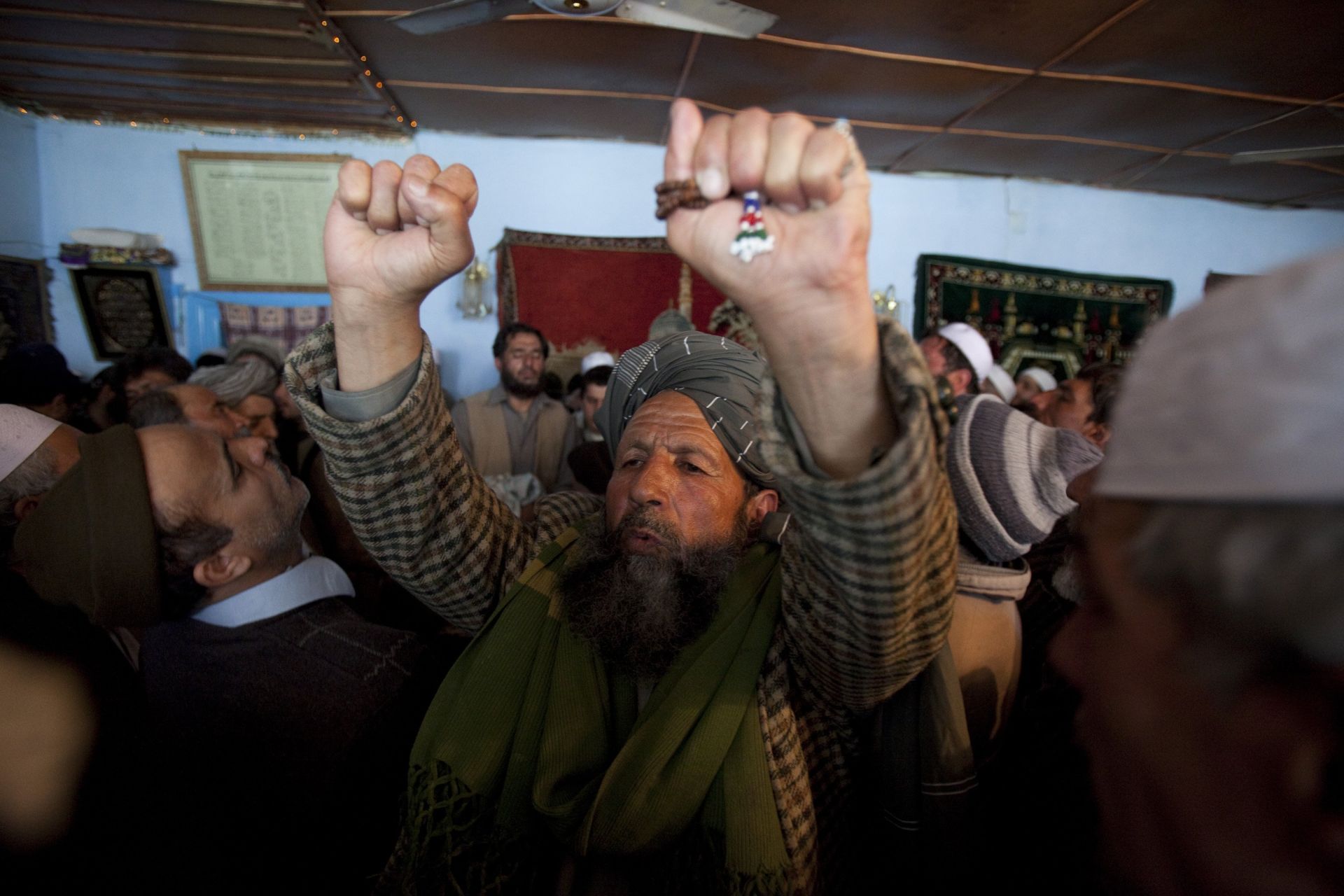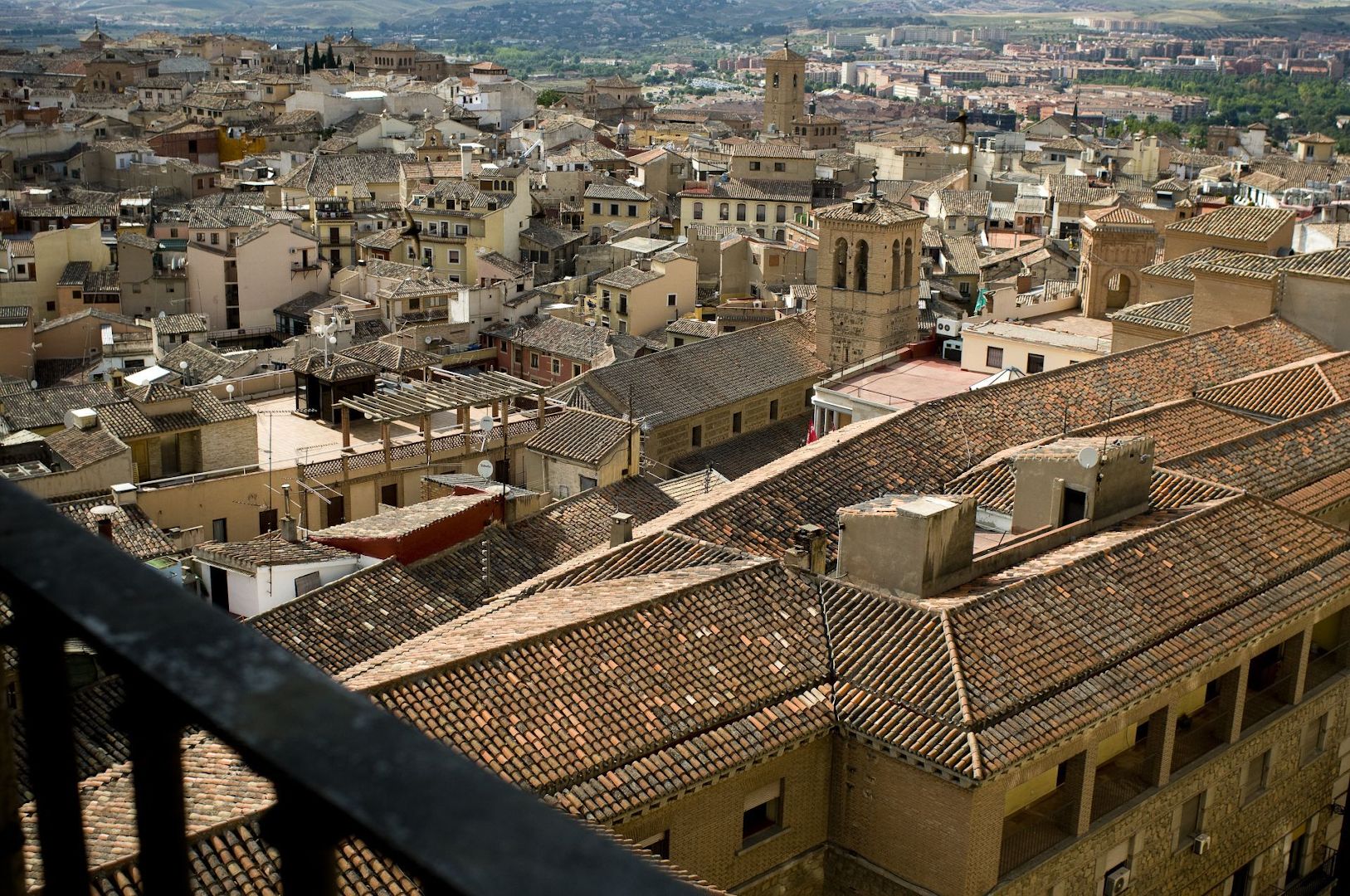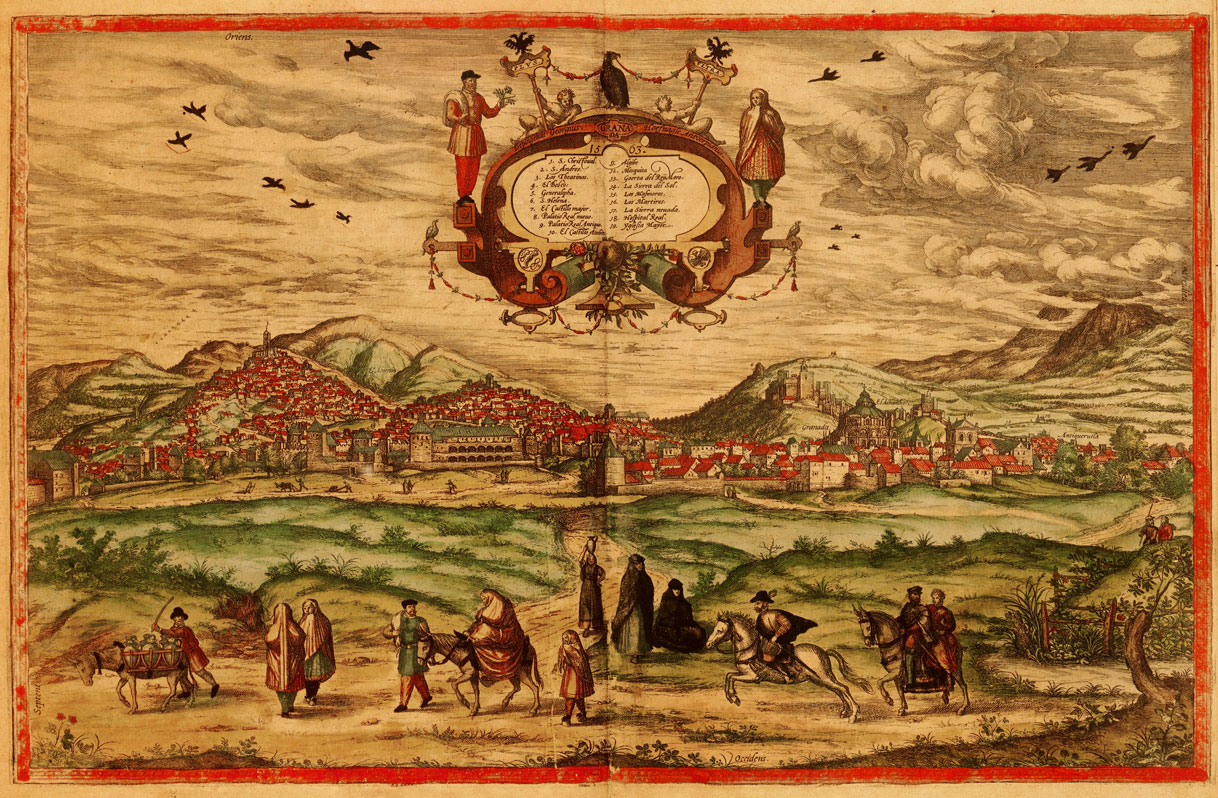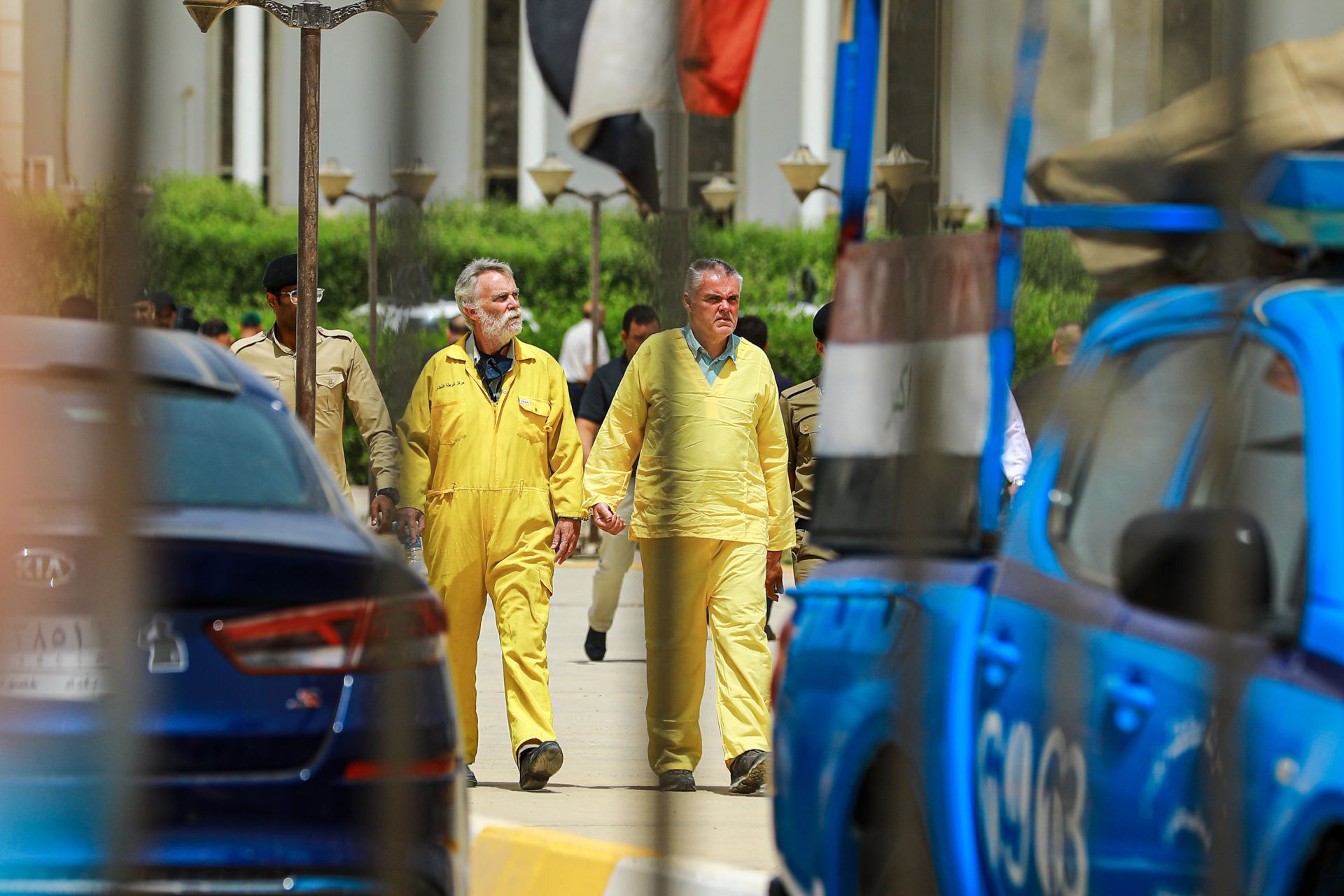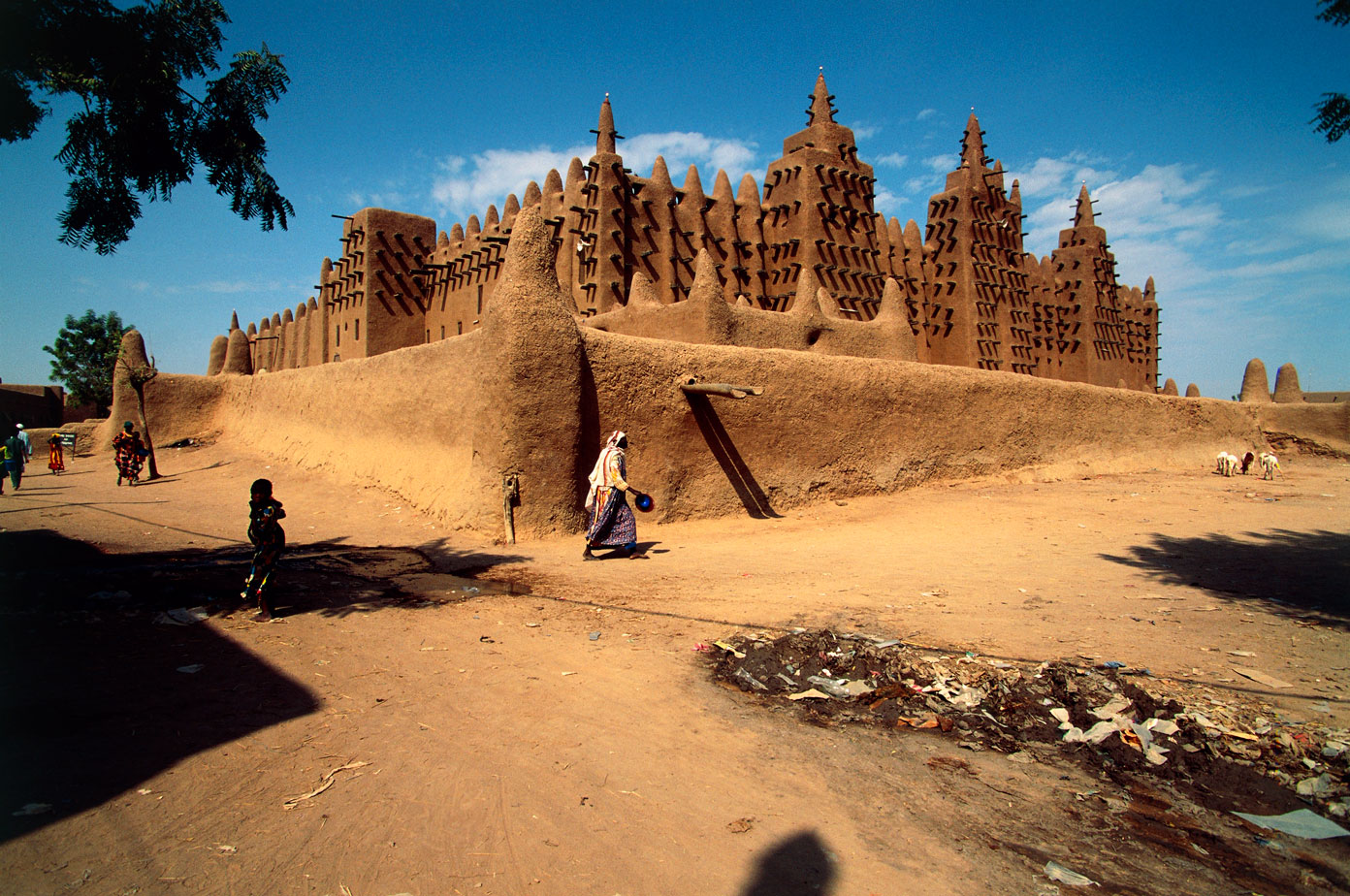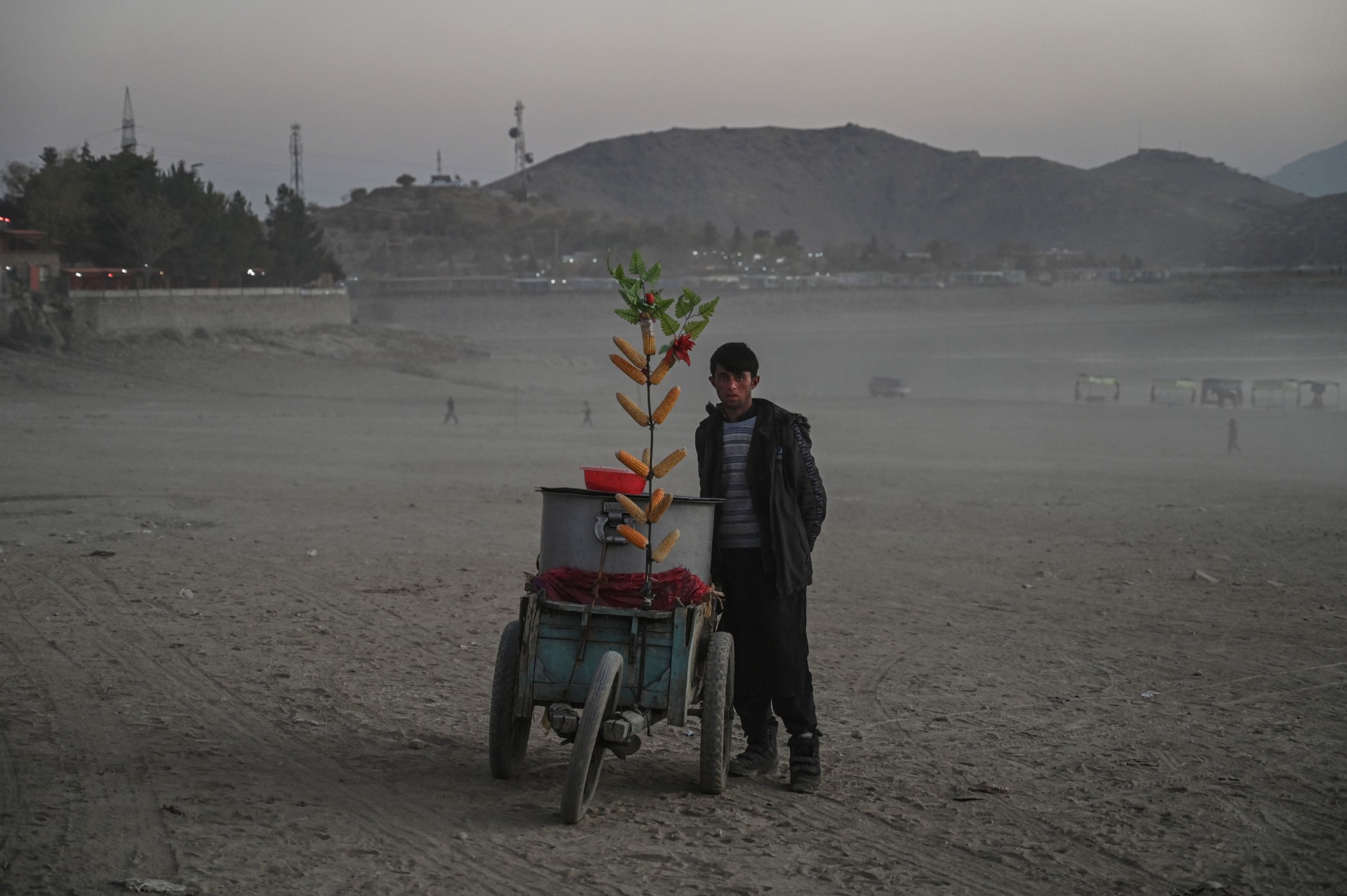The vibrant history of successful Muslim women has been disregarded and dismissed by conservative groups like the Taliban
June 3, 2022
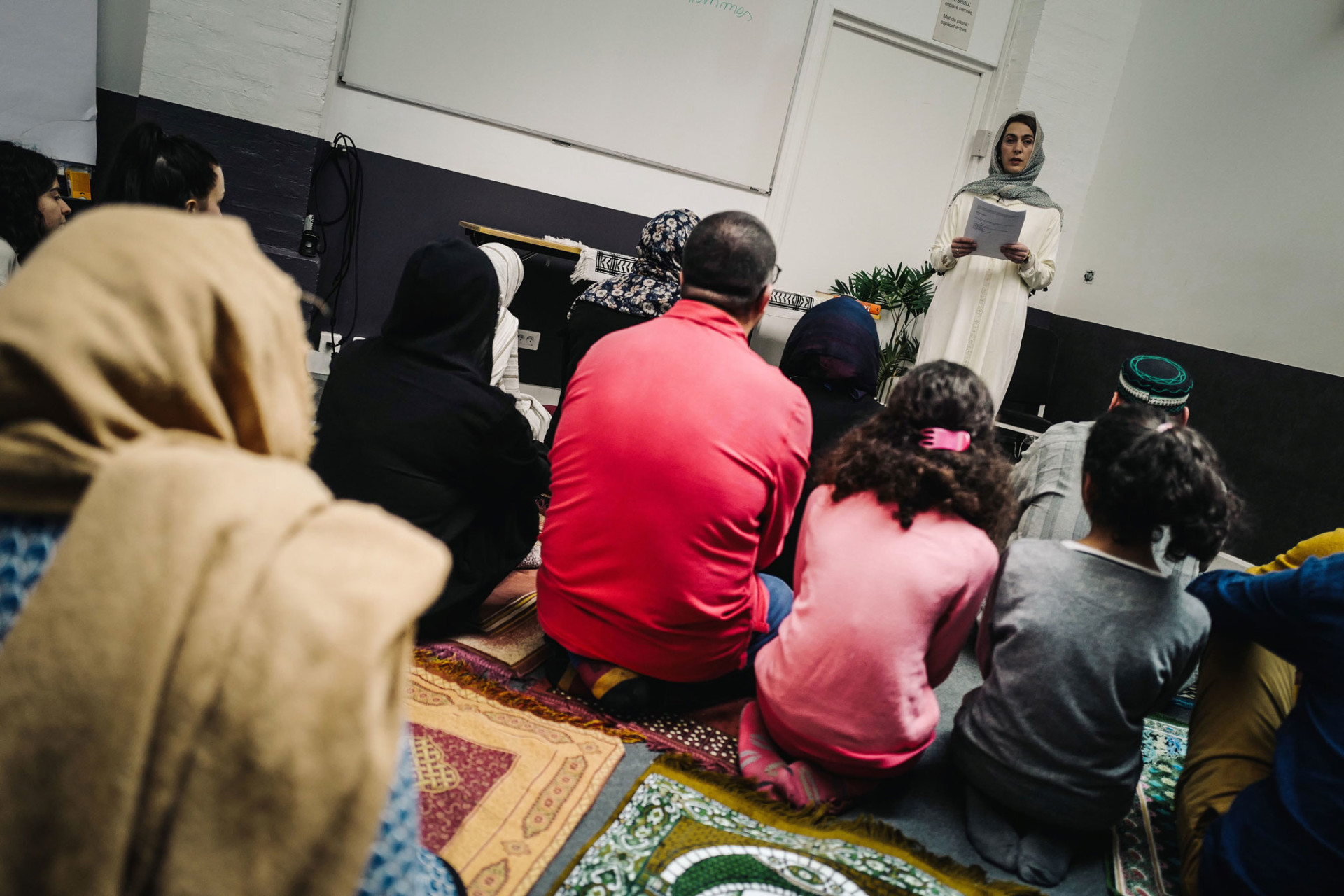 French female imam Kahina Bahloul leads a Friday prayer in Paris on Feb. 21, 2020 / Lucas Barioulet / AFP via Getty Images
French female imam Kahina Bahloul leads a Friday prayer in Paris on Feb. 21, 2020 / Lucas Barioulet / AFP via Getty Images
On the outskirts of Kabul, beneath shimmering snowflakes on a winter’s morning in 1099 CE, thousands braved the frost as they followed the bier of an eminent scholar and the region’s mufti. No, dear reader, this was not a man, but a woman: Biba al-Harthamiah. Biba was just one of hundreds of Muslim female scholars who once occupied positions of prestige and influence in the Muslim world yet who are now all but forgotten.
For 20 years, Afghan women and girls were permitted to excel in areas as diverse as jurisprudence, medicine, academia, professional soccer, robotics and classical music. Yet the current leadership is defining these accomplishments as part of an aberrant period, in conflict with Afghan historical culture and traditional Islamic norms. The Taliban are asserting a vision of Afghan society in which women can be prohibited from many areas of social participation and must abide by strict gender norms and forms of male guardianship.
Outside observers may thus understandably assume that Islam discourages or forbids female empowerment, success and participation in secular society. The association of Islam with restrictive gender norms and discouraging women and girls from developing and exercising self-agency is not a dilemma only for Afghan women. It is a genuine issue in different places: Muslim women in less-constrained societies often struggle with conflicting frameworks of values, one in which they are encouraged to develop their potential and contribute to society and another in which straying from clearly defined gender limitations is seen to detract from their piety, dignity and responsibilities as daughters, wives or mothers.
Ultraconservatives justify their restrictive treatment of women on two primary bases, namely Islam and historical cultural norms. But how definitive are these bases in substantiating their worldview? The strict patriarchal views espoused by the Taliban, and indeed others, primarily stem from their understanding of Quranic references such as “qawamah” and “nushuz,” often mistranslated as “guardianship” and “rebelliousness,” respectively. According to the worldview of the Taliban and other patriarchal interpreters, these concepts designate men as naturally superior to women and invest men with the control and responsibility of guardianship over them. In this worldview, women cannot be trusted to make decisions on their own and are regarded as susceptible to error and corruption.
Added to these concepts are pre-Islamic tribal ideals of morality and shame, linking women’s behavior to the honor of men and society. In this conception of society, men need to keep women in order, constraining their “evil” and preventing women from bringing shame on them, their family name and their community. This unfortunate cultural mindset underlies many harmful social practices and, in extreme cases, produces evils such as honor killing.
The interpretation of “qawwamun” as “guardians” relies on an association with the related word “qa’imun,” which means guardian or caretaker. Though sharing a root, the words have two distinctive connotations — the former is about flexible support, the latter about providing guardianship. A variation of the former concept, in the context of a building the word “qawa’im” refers to its internal supporting pillars; on the other hand, the “qa’imun” of a building are its custodians and guardians. Even Abdel Aziz Bin Baz, the former Saudi mufti, said in commentary about the verses: “The qawamah of men is one of responsibility to provide care (takleef) and not a privilege (tashreef).”
The term “nushuz” — commonly interpreted as female rebelliousness — literally describes the protruding fangs of an antagonized snake secreting venom. This image implies that “nushuz” is not a female characteristic or permanent state of being but a situation that arises from time to time in reaction to a threat. The Quran employs the term “nushuz” only twice, both in the same chapter, once in reference to women (4:34) and once in reference to men (4:128). Rather than an essential character deficiency in women, this word describes a situation that refers to either or both parties in the marriage, which can be remedied with the correct intervention. Hence, a more accurate understanding of “nushuz” refers to a toxic atmosphere in a relationship or in the behavior of the parties involved.
The conservative interpretation of these two terms is difficult to square when “nushuz” is applied equally to men and women: If men are superior guardians of women, how can they be described on their terms, as “rebellious and disobedient”? To maintain their interpretation, the text has to be further manipulated by providing a different definition of “nushuz” for a man — it is when they “deny their wives carnal gratification.” Yet, far from justifying a rigid patriarchal hierarchy, the Quran speaks of the importance of mutual support between husband and wife and offers ways for both men and women to address and heal from toxicity within their marriage.
Prior to the advent of puritanical or fundamental movements, the more constraining view of women needing guardians instead of support was not the dominant view. This view seems widely accepted because it has been emphasized in public discourse to the extent that it has become normative within the Muslim community. This, in turn, makes it difficult to discuss the alternative view without sounding revisionist. In other words, this is not a problem of original sources but of ideological indoctrination. Still, the point here is not to tackle an ideological mindset and prove or disprove one reading or the other definitively, but to show that the meaning as defined by conservatives is not as universally agreed as they make it sound. Do not take my word for it — the 13th-century classical Arabic dictionary Lisan al-Arab has an entry about verse 4:34 substantiating the distinction between “qawwamun” and “qa’imun” as made earlier, in contrast to the common interpretation espoused by conservative groups.
The terms are appropriated to suit restrictive measures imposed by society, which brings us to the second basis of the conservative justification, namely Afghan cultural norms that ignore history, as the forgotten story of Biba al-Harthamiah demonstrates.
The legacy of outstanding Muslim women stretches back to the days of the Prophet Muhammad, who not only considered women capable of leadership but also appointed them to prominent positions. This is unsurprising, given that he and his successors had several female mentors. He had worked for his first wife, Khadijah, running her business between Mecca and the Levant, until their marriage. Barakah, also known by her epitaph Umm Ayman, served as a close adviser to two of his successors (Abu Bakr and Umar), who held her counsel in high regard.
While there is a common understanding among Muslims that women cannot hold positions of religious leadership or scholarship, the Prophet Muhammad himself provided two clear counterexamples: naming Umm Waraqah as an imam of her community and Ash-Shifa bint Abdillah as Medina’s head educator. He named Umm Waraqah as an imam “because she had mastered the art of the Quran and memorized it” and assigned to her a muezzin, the person who calls people to prayers at the mosque. The implication was that the Prophet allowed a woman to lead congregational prayers, and this congregation was open to those outside of her immediate family and household.
The majority of Islamic scholars agree that a woman can lead other women in prayers, especially among three of the four main Sunni schools of jurisprudence — the Hanafi, Shafi’i and Hanbali — based on the example of both Aishah and Umm Salamah leading women in prayers. However, scholars differ on whether a woman can lead men in prayer. They cite limitations of rearing children, menstruation and other responsibilities that make it difficult for women to lead prayers regularly. This remains a point of contention and an open debate.
Based on the examples of Umm Waraqah and Ash-Shifa, eminent scholars such as At-Tabari (ninth century), Ibn Hazm (11th), Ibn Rushd (Averroes) (12th) and Ibn Abidin (19th) have declared that a woman can hold public office.
Though Umm Waraqah is virtually unknown today, she is referenced in numerous manuscripts held in Timbuktu, Damascus, Istanbul and other places, including highly authoritative works like “Al-Ahkam As-Sultaniyyah” by Abu al-Hassan al-Mawardi in the 11th century, “Al-Mughni” by Ibn Qudamah al-Maqdisi (13th) and “Irwa al-Ghalil” by Nasir al-Din al-Albani, who died in 1999. A reference to the Prophet Muhammad’s actions by Ibn al-Qattan, an authority on Hadith in 13th-century Córdoba, mentions “Imamatu Umm Waraqata bi-qawmiha” (Umm Waraqa leading her people), which is broader than her neighborhood, implying that she led a larger district. Another acclaimed scholar further east in 13th-century Syria, An-Nawawi, also cited three top jurists as permitting women to lead men in prayer.
Even the strict Ibn Taymiyyah, the ideological inspiration for several ultraconservative movements today, declared, “Ahmad [founder of the Hanbali school] permitted a woman to lead men in prayer, when the need arises, in cases when she is an expert on the Quran, when men are not, so she can lead them in the night prayers of Ramadan [“taraweeh”], the same way that the Prophet anointed Umm Waraqah as an Imam for her neighborhood and assigned a muezzin to her.” Ibn Taymiyyah clearly reiterates: “I say, for men to be led by a woman who is an expert in the Quran during taraweeh is permissible, based on the widely known [traditions] from the opinion of Ahmad.”
Summing up the general view, Andalusian sage Ibn Arabi declared, “There are those who unconditionally permit women to lead men in prayers, which is my opinion as well. There are those who completely prohibit her from such leadership and there are those who permit her to lead women, but not men.” He further explains his view, “The default state is that her leadership is permissible, and one should not heed to those who prohibit it without concrete proof, for there is no clear text to support their claim, and any evidence they bring forth could include them in the prohibition as well, thereby neutralizing the evidence in this regard, and maintaining the default state of her leadership’s permissibility.”
The Prophet Muhammad declared education not only a fundamental right, but also a solemn duty of all his followers. He taught that to teach a man is to educate an individual, yet to teach a woman is to inspire a nation.
The Prophet Muhammad declared education not only a fundamental right but also a solemn duty of all his followers. In fact, he taught that to teach a man is to educate an individual, yet to teach a woman is to inspire a nation. He understood very well that women not only teach their children but also influence their husbands. And if their husbands are powerful, they affect entire communities and a nation.
The Quran advises its readers, both female and male, to compete in seeking knowledge, and over 40 times it invokes not just rote memorization but the more nuanced concept of “aql,” connoting the development and use of reason and rational synthesis based on extensive research and analysis. Furthermore, the Quran instructed readers to increase their capacity in all forms of beneficial knowledge and understanding. It employed the concept of “ilm” in its indefinite form to encompass both spiritual and secular knowledge, as attested by the Prophet Muhammad hiring math and language tutors for his wife.
When the Prophet died in 632, his legacy to posterity was a book: the first manuscript of the Quran, the very first book to be written in the Arabic language. Despite the many men who could have been given the honor of custodianship of the manuscript, it was entrusted to a woman: Hafsah Bint Umar. Muhammad’s choice to give this task to a woman indicates that he held women in high regard. It was this very copy that would later be borrowed by Uthman, the third caliph, to compile the five standard copies of the scripture.
Biba Al-Harthamiah, the eminent female scholar from medieval Kabul, was not an anomaly. We have detailed records of scholars and teachers, thanks to the traditional Islamic approach to learning, whereby scholars established their credibility via unbroken chains of transmission. What is truly remarkable is the sheer number of women under whom eminent Islamic scholars studied. For example, 12th-century scholar Ibn al-Samaani studied under 69 female scholars; Muhammad Ibn al-Najjar (13th century) studied under 400 female scholars; Al-Sakhawi (15th) studied under 60 female scholars; and Al-Suyuti (16th) studied under 59 female scholars.
This trend was set from the very beginning of Islam. Thousands of men attended the great seventh-century jurist Umm Ad-Darda As-Sughra’s classes at the Umayyad Mosque, including the caliph Abdul-Malik ibn Marwan, who himself sat on the ground at her feet. In fact, one of her students, the celebrated scholar Iyas ibn Muawiyah al-Muzani, considered her to be the supreme authority of her time, surpassing all others.
In the 12th century, Fatimah As-Samarqandi was the mufti of Samarqand and served as an adviser and mentor to the legendary Crusades-era Salahaddin (Saladin). Fatimah was a brilliant scholar who amassed many certifications (called ijazah) from the most prominent scholars of her age and taught at prestigious academies in Syria.
Zaynab Bint al-Kamal of Damascus, one of scores of female teachers who taught the prolific Syrian scholar and historian Ibn Kathir, was considered a leading authority in the conservative Hanbali school in the 14th century. Several scholars of the school, including Ibn Taymiyyah, remarked how “she stood upon the pulpit with authority and spoke with great eloquence and erudition.” Zaynab was considered the top authority in the discipline of Hadith and was granted the prestigious title “Musnidat al-Sham” (senior transmission authority of the Levant).
Not only did women teach across the Islamic world, they also dominated many educational settings as students as well. The 12th-century eminent Syrian scholar Ibn Asakir documented concerns by men of his time about how women in classes “outnumbered” and “intimidated” them because of their “strong confidence and character.” Ibn Asakir informs us, “I personally studied at the feet of 80 female scholars, who surpassed their male counterparts in their respective fields.”
It is estimated that from the years 800 to 1100, Muslim women were credited with establishing over 35% of libraries and academic institutions in the Islamic world. They were led by the likes of Zubaidah (ninth century), who was a driving force and main sponsor behind the famed Bayt al-Hikamah at the time (The House of Wisdom) and Fatima al-Fihri, who established the world’s oldest, continually running university in 859 in Fez, Morocco. Both institutions had vast libraries, counting tens of thousands of books, launched with donations by these entrepreneurial women.
Women not only served as scholars and patrons of the arts but also held prominent positions of public authority. Influential women who held such offices included Lubna of Córdoba. An adviser to the caliph and polymath, Lubna distinguished herself as a master librarian and acquisition expert. When establishing the famed library at Medinat al-Zahra, she teamed up with Jewish scholar Hasdai ibn Shaprut to assemble a valuable collection of some 500,000 books. Despite being a former slave, 12th-century biographer Ibn Bashkuwal described Lubna as a “scholarly author, grammarian, poetess, erudite in arithmetic, comprehensive in her learning; none in the citadel was as noble as she.”
The formerly enslaved African, Thamal Al-Qahramanah, made history in 918 when she became the first female justice of the powerful Abbasid Empire. Notable scholars such as the 12th century’s Ibn al-Jawzi and al-Suyuti in the 16th century provided details of her office and mentioned that it “was not considered unusual at the time for a woman to preside over men in a public office so high.”
Women also ruled or governed, with over 90 attaining the position of “al-malikah al-hurrah,” meaning “the independent, sovereign queen.” Among those who combined both secular and academic authority were Razia of Delhi in the 13th century, patron of schools and libraries in northern India, and the 12th century’s Arwa As-Sulaihi, who was the senior scholarly authority and ruler of Yemen. Attaining the prestigious academic rank of “hujjah,” meaning “proof” or ”authority,” she is credited with establishing many of Yemen’s public libraries and academic institutions.
Why is it that, with such strong textual evidence, as well as practical evidence like the fact that women can pray next to men in the holy mosque in Mecca, women are still relegated to the back of so many mosques? Why is scripture in conflict with general behavior? On what basis did some communities decide to allow women to have a public role, and why did others turn their back on this rich history?
In some places, women can be jailed for preaching Islam in public, while in others, such as Turkey, they are increasing in number, with several hundred female preachers in the country, some even leading pilgrims to Mecca. Hui Muslim women in China have had their own mosques, where women have led them for over 300 years.
In Iran, a ban on women leading prayers was lifted in 2000, after a group of high-ranking ayatollahs issued the decree. Ali Asghar Nuri, then an official in the Iranian Education Ministry, said: “The employment of women as leaders of Friday congregation prayers at the head of other women during prayers held at schools constitutes a major development.”
Where does this leave us now? From the largely forgotten legacy of Muslim women, we learn that the development of women’s potential and their leadership is not inherently against an Islamic framework of values; it has, in fact, figured prominently throughout Muslim history. Yet we witness other voices, both in history and in our contemporary world, which present a much more constraining perspective toward women. Hence, the fundamental question is not whether Islam encourages or constrains women’s empowerment and exercise of leadership but rather who controls the narrative.
Understanding the history of Islam and the behavior of its founder provides a healthy example for the contemporary world. Though Afghanistan’s leaders may have forgotten Biba Al-Harthamiah, Afghans and others would do well to remember they once had leaders like her.
 French female imam Kahina Bahloul leads a Friday prayer in Paris on Feb. 21, 2020 / Lucas Barioulet / AFP via Getty Images
French female imam Kahina Bahloul leads a Friday prayer in Paris on Feb. 21, 2020 / Lucas Barioulet / AFP via Getty ImagesOn the outskirts of Kabul, beneath shimmering snowflakes on a winter’s morning in 1099 CE, thousands braved the frost as they followed the bier of an eminent scholar and the region’s mufti. No, dear reader, this was not a man, but a woman: Biba al-Harthamiah. Biba was just one of hundreds of Muslim female scholars who once occupied positions of prestige and influence in the Muslim world yet who are now all but forgotten.
For 20 years, Afghan women and girls were permitted to excel in areas as diverse as jurisprudence, medicine, academia, professional soccer, robotics and classical music. Yet the current leadership is defining these accomplishments as part of an aberrant period, in conflict with Afghan historical culture and traditional Islamic norms. The Taliban are asserting a vision of Afghan society in which women can be prohibited from many areas of social participation and must abide by strict gender norms and forms of male guardianship.
Outside observers may thus understandably assume that Islam discourages or forbids female empowerment, success and participation in secular society. The association of Islam with restrictive gender norms and discouraging women and girls from developing and exercising self-agency is not a dilemma only for Afghan women. It is a genuine issue in different places: Muslim women in less-constrained societies often struggle with conflicting frameworks of values, one in which they are encouraged to develop their potential and contribute to society and another in which straying from clearly defined gender limitations is seen to detract from their piety, dignity and responsibilities as daughters, wives or mothers.
Ultraconservatives justify their restrictive treatment of women on two primary bases, namely Islam and historical cultural norms. But how definitive are these bases in substantiating their worldview? The strict patriarchal views espoused by the Taliban, and indeed others, primarily stem from their understanding of Quranic references such as “qawamah” and “nushuz,” often mistranslated as “guardianship” and “rebelliousness,” respectively. According to the worldview of the Taliban and other patriarchal interpreters, these concepts designate men as naturally superior to women and invest men with the control and responsibility of guardianship over them. In this worldview, women cannot be trusted to make decisions on their own and are regarded as susceptible to error and corruption.
Added to these concepts are pre-Islamic tribal ideals of morality and shame, linking women’s behavior to the honor of men and society. In this conception of society, men need to keep women in order, constraining their “evil” and preventing women from bringing shame on them, their family name and their community. This unfortunate cultural mindset underlies many harmful social practices and, in extreme cases, produces evils such as honor killing.
The interpretation of “qawwamun” as “guardians” relies on an association with the related word “qa’imun,” which means guardian or caretaker. Though sharing a root, the words have two distinctive connotations — the former is about flexible support, the latter about providing guardianship. A variation of the former concept, in the context of a building the word “qawa’im” refers to its internal supporting pillars; on the other hand, the “qa’imun” of a building are its custodians and guardians. Even Abdel Aziz Bin Baz, the former Saudi mufti, said in commentary about the verses: “The qawamah of men is one of responsibility to provide care (takleef) and not a privilege (tashreef).”
The term “nushuz” — commonly interpreted as female rebelliousness — literally describes the protruding fangs of an antagonized snake secreting venom. This image implies that “nushuz” is not a female characteristic or permanent state of being but a situation that arises from time to time in reaction to a threat. The Quran employs the term “nushuz” only twice, both in the same chapter, once in reference to women (4:34) and once in reference to men (4:128). Rather than an essential character deficiency in women, this word describes a situation that refers to either or both parties in the marriage, which can be remedied with the correct intervention. Hence, a more accurate understanding of “nushuz” refers to a toxic atmosphere in a relationship or in the behavior of the parties involved.
The conservative interpretation of these two terms is difficult to square when “nushuz” is applied equally to men and women: If men are superior guardians of women, how can they be described on their terms, as “rebellious and disobedient”? To maintain their interpretation, the text has to be further manipulated by providing a different definition of “nushuz” for a man — it is when they “deny their wives carnal gratification.” Yet, far from justifying a rigid patriarchal hierarchy, the Quran speaks of the importance of mutual support between husband and wife and offers ways for both men and women to address and heal from toxicity within their marriage.
Prior to the advent of puritanical or fundamental movements, the more constraining view of women needing guardians instead of support was not the dominant view. This view seems widely accepted because it has been emphasized in public discourse to the extent that it has become normative within the Muslim community. This, in turn, makes it difficult to discuss the alternative view without sounding revisionist. In other words, this is not a problem of original sources but of ideological indoctrination. Still, the point here is not to tackle an ideological mindset and prove or disprove one reading or the other definitively, but to show that the meaning as defined by conservatives is not as universally agreed as they make it sound. Do not take my word for it — the 13th-century classical Arabic dictionary Lisan al-Arab has an entry about verse 4:34 substantiating the distinction between “qawwamun” and “qa’imun” as made earlier, in contrast to the common interpretation espoused by conservative groups.
The terms are appropriated to suit restrictive measures imposed by society, which brings us to the second basis of the conservative justification, namely Afghan cultural norms that ignore history, as the forgotten story of Biba al-Harthamiah demonstrates.
The legacy of outstanding Muslim women stretches back to the days of the Prophet Muhammad, who not only considered women capable of leadership but also appointed them to prominent positions. This is unsurprising, given that he and his successors had several female mentors. He had worked for his first wife, Khadijah, running her business between Mecca and the Levant, until their marriage. Barakah, also known by her epitaph Umm Ayman, served as a close adviser to two of his successors (Abu Bakr and Umar), who held her counsel in high regard.
While there is a common understanding among Muslims that women cannot hold positions of religious leadership or scholarship, the Prophet Muhammad himself provided two clear counterexamples: naming Umm Waraqah as an imam of her community and Ash-Shifa bint Abdillah as Medina’s head educator. He named Umm Waraqah as an imam “because she had mastered the art of the Quran and memorized it” and assigned to her a muezzin, the person who calls people to prayers at the mosque. The implication was that the Prophet allowed a woman to lead congregational prayers, and this congregation was open to those outside of her immediate family and household.
The majority of Islamic scholars agree that a woman can lead other women in prayers, especially among three of the four main Sunni schools of jurisprudence — the Hanafi, Shafi’i and Hanbali — based on the example of both Aishah and Umm Salamah leading women in prayers. However, scholars differ on whether a woman can lead men in prayer. They cite limitations of rearing children, menstruation and other responsibilities that make it difficult for women to lead prayers regularly. This remains a point of contention and an open debate.
Based on the examples of Umm Waraqah and Ash-Shifa, eminent scholars such as At-Tabari (ninth century), Ibn Hazm (11th), Ibn Rushd (Averroes) (12th) and Ibn Abidin (19th) have declared that a woman can hold public office.
Though Umm Waraqah is virtually unknown today, she is referenced in numerous manuscripts held in Timbuktu, Damascus, Istanbul and other places, including highly authoritative works like “Al-Ahkam As-Sultaniyyah” by Abu al-Hassan al-Mawardi in the 11th century, “Al-Mughni” by Ibn Qudamah al-Maqdisi (13th) and “Irwa al-Ghalil” by Nasir al-Din al-Albani, who died in 1999. A reference to the Prophet Muhammad’s actions by Ibn al-Qattan, an authority on Hadith in 13th-century Córdoba, mentions “Imamatu Umm Waraqata bi-qawmiha” (Umm Waraqa leading her people), which is broader than her neighborhood, implying that she led a larger district. Another acclaimed scholar further east in 13th-century Syria, An-Nawawi, also cited three top jurists as permitting women to lead men in prayer.
Even the strict Ibn Taymiyyah, the ideological inspiration for several ultraconservative movements today, declared, “Ahmad [founder of the Hanbali school] permitted a woman to lead men in prayer, when the need arises, in cases when she is an expert on the Quran, when men are not, so she can lead them in the night prayers of Ramadan [“taraweeh”], the same way that the Prophet anointed Umm Waraqah as an Imam for her neighborhood and assigned a muezzin to her.” Ibn Taymiyyah clearly reiterates: “I say, for men to be led by a woman who is an expert in the Quran during taraweeh is permissible, based on the widely known [traditions] from the opinion of Ahmad.”
Summing up the general view, Andalusian sage Ibn Arabi declared, “There are those who unconditionally permit women to lead men in prayers, which is my opinion as well. There are those who completely prohibit her from such leadership and there are those who permit her to lead women, but not men.” He further explains his view, “The default state is that her leadership is permissible, and one should not heed to those who prohibit it without concrete proof, for there is no clear text to support their claim, and any evidence they bring forth could include them in the prohibition as well, thereby neutralizing the evidence in this regard, and maintaining the default state of her leadership’s permissibility.”
The Prophet Muhammad declared education not only a fundamental right, but also a solemn duty of all his followers. He taught that to teach a man is to educate an individual, yet to teach a woman is to inspire a nation.
The Prophet Muhammad declared education not only a fundamental right but also a solemn duty of all his followers. In fact, he taught that to teach a man is to educate an individual, yet to teach a woman is to inspire a nation. He understood very well that women not only teach their children but also influence their husbands. And if their husbands are powerful, they affect entire communities and a nation.
The Quran advises its readers, both female and male, to compete in seeking knowledge, and over 40 times it invokes not just rote memorization but the more nuanced concept of “aql,” connoting the development and use of reason and rational synthesis based on extensive research and analysis. Furthermore, the Quran instructed readers to increase their capacity in all forms of beneficial knowledge and understanding. It employed the concept of “ilm” in its indefinite form to encompass both spiritual and secular knowledge, as attested by the Prophet Muhammad hiring math and language tutors for his wife.
When the Prophet died in 632, his legacy to posterity was a book: the first manuscript of the Quran, the very first book to be written in the Arabic language. Despite the many men who could have been given the honor of custodianship of the manuscript, it was entrusted to a woman: Hafsah Bint Umar. Muhammad’s choice to give this task to a woman indicates that he held women in high regard. It was this very copy that would later be borrowed by Uthman, the third caliph, to compile the five standard copies of the scripture.
Biba Al-Harthamiah, the eminent female scholar from medieval Kabul, was not an anomaly. We have detailed records of scholars and teachers, thanks to the traditional Islamic approach to learning, whereby scholars established their credibility via unbroken chains of transmission. What is truly remarkable is the sheer number of women under whom eminent Islamic scholars studied. For example, 12th-century scholar Ibn al-Samaani studied under 69 female scholars; Muhammad Ibn al-Najjar (13th century) studied under 400 female scholars; Al-Sakhawi (15th) studied under 60 female scholars; and Al-Suyuti (16th) studied under 59 female scholars.
This trend was set from the very beginning of Islam. Thousands of men attended the great seventh-century jurist Umm Ad-Darda As-Sughra’s classes at the Umayyad Mosque, including the caliph Abdul-Malik ibn Marwan, who himself sat on the ground at her feet. In fact, one of her students, the celebrated scholar Iyas ibn Muawiyah al-Muzani, considered her to be the supreme authority of her time, surpassing all others.
In the 12th century, Fatimah As-Samarqandi was the mufti of Samarqand and served as an adviser and mentor to the legendary Crusades-era Salahaddin (Saladin). Fatimah was a brilliant scholar who amassed many certifications (called ijazah) from the most prominent scholars of her age and taught at prestigious academies in Syria.
Zaynab Bint al-Kamal of Damascus, one of scores of female teachers who taught the prolific Syrian scholar and historian Ibn Kathir, was considered a leading authority in the conservative Hanbali school in the 14th century. Several scholars of the school, including Ibn Taymiyyah, remarked how “she stood upon the pulpit with authority and spoke with great eloquence and erudition.” Zaynab was considered the top authority in the discipline of Hadith and was granted the prestigious title “Musnidat al-Sham” (senior transmission authority of the Levant).
Not only did women teach across the Islamic world, they also dominated many educational settings as students as well. The 12th-century eminent Syrian scholar Ibn Asakir documented concerns by men of his time about how women in classes “outnumbered” and “intimidated” them because of their “strong confidence and character.” Ibn Asakir informs us, “I personally studied at the feet of 80 female scholars, who surpassed their male counterparts in their respective fields.”
It is estimated that from the years 800 to 1100, Muslim women were credited with establishing over 35% of libraries and academic institutions in the Islamic world. They were led by the likes of Zubaidah (ninth century), who was a driving force and main sponsor behind the famed Bayt al-Hikamah at the time (The House of Wisdom) and Fatima al-Fihri, who established the world’s oldest, continually running university in 859 in Fez, Morocco. Both institutions had vast libraries, counting tens of thousands of books, launched with donations by these entrepreneurial women.
Women not only served as scholars and patrons of the arts but also held prominent positions of public authority. Influential women who held such offices included Lubna of Córdoba. An adviser to the caliph and polymath, Lubna distinguished herself as a master librarian and acquisition expert. When establishing the famed library at Medinat al-Zahra, she teamed up with Jewish scholar Hasdai ibn Shaprut to assemble a valuable collection of some 500,000 books. Despite being a former slave, 12th-century biographer Ibn Bashkuwal described Lubna as a “scholarly author, grammarian, poetess, erudite in arithmetic, comprehensive in her learning; none in the citadel was as noble as she.”
The formerly enslaved African, Thamal Al-Qahramanah, made history in 918 when she became the first female justice of the powerful Abbasid Empire. Notable scholars such as the 12th century’s Ibn al-Jawzi and al-Suyuti in the 16th century provided details of her office and mentioned that it “was not considered unusual at the time for a woman to preside over men in a public office so high.”
Women also ruled or governed, with over 90 attaining the position of “al-malikah al-hurrah,” meaning “the independent, sovereign queen.” Among those who combined both secular and academic authority were Razia of Delhi in the 13th century, patron of schools and libraries in northern India, and the 12th century’s Arwa As-Sulaihi, who was the senior scholarly authority and ruler of Yemen. Attaining the prestigious academic rank of “hujjah,” meaning “proof” or ”authority,” she is credited with establishing many of Yemen’s public libraries and academic institutions.
Why is it that, with such strong textual evidence, as well as practical evidence like the fact that women can pray next to men in the holy mosque in Mecca, women are still relegated to the back of so many mosques? Why is scripture in conflict with general behavior? On what basis did some communities decide to allow women to have a public role, and why did others turn their back on this rich history?
In some places, women can be jailed for preaching Islam in public, while in others, such as Turkey, they are increasing in number, with several hundred female preachers in the country, some even leading pilgrims to Mecca. Hui Muslim women in China have had their own mosques, where women have led them for over 300 years.
In Iran, a ban on women leading prayers was lifted in 2000, after a group of high-ranking ayatollahs issued the decree. Ali Asghar Nuri, then an official in the Iranian Education Ministry, said: “The employment of women as leaders of Friday congregation prayers at the head of other women during prayers held at schools constitutes a major development.”
Where does this leave us now? From the largely forgotten legacy of Muslim women, we learn that the development of women’s potential and their leadership is not inherently against an Islamic framework of values; it has, in fact, figured prominently throughout Muslim history. Yet we witness other voices, both in history and in our contemporary world, which present a much more constraining perspective toward women. Hence, the fundamental question is not whether Islam encourages or constrains women’s empowerment and exercise of leadership but rather who controls the narrative.
Understanding the history of Islam and the behavior of its founder provides a healthy example for the contemporary world. Though Afghanistan’s leaders may have forgotten Biba Al-Harthamiah, Afghans and others would do well to remember they once had leaders like her.
Mohamad Jebara is the author of “Muhammad the World-Changer: An Intimate Portrait” and the forthcoming “Life of the Qur’an”
